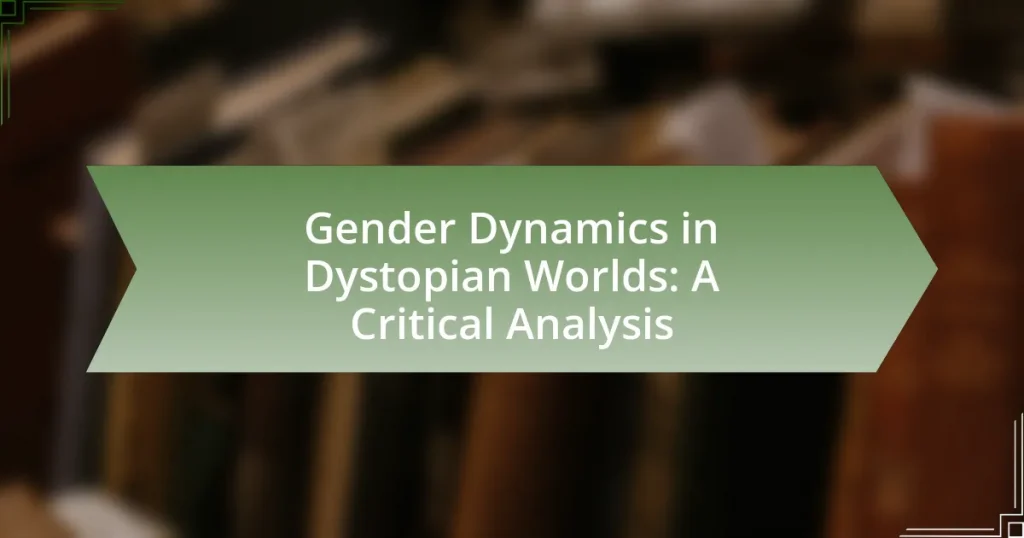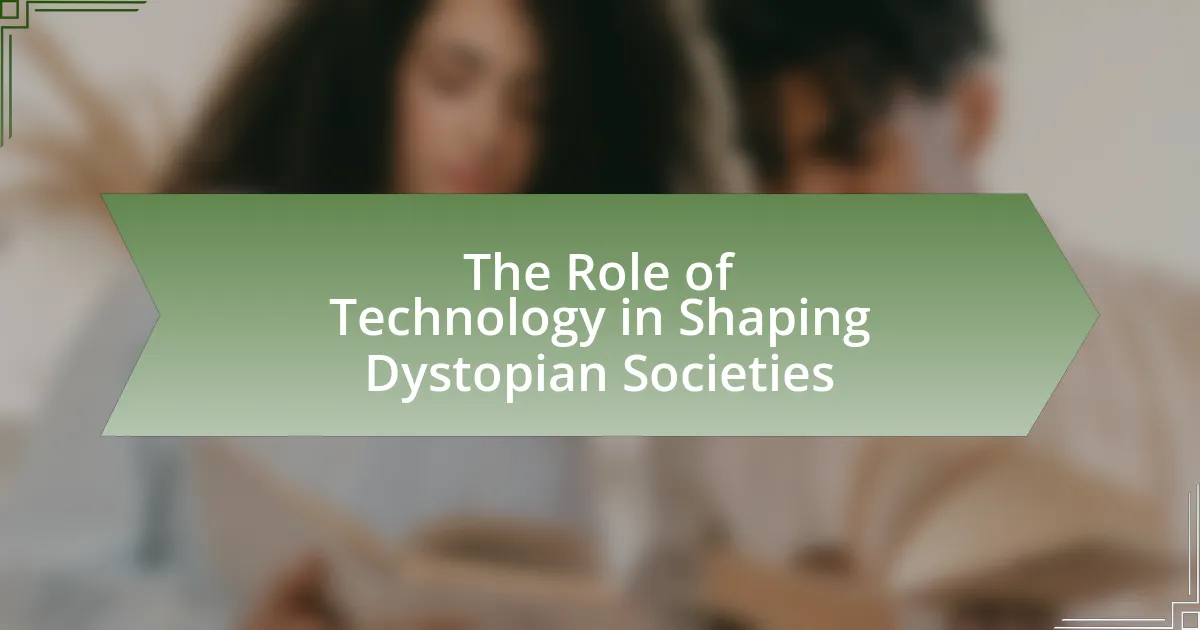Gender dynamics in dystopian worlds are characterized by extreme inequalities and power imbalances, often depicting women in subservient roles while men hold authority. This article critically analyzes how dystopian narratives, such as Margaret Atwood’s “The Handmaid’s Tale” and George Orwell’s “1984,” illustrate these dynamics, emphasizing themes of oppression, identity, and the manipulation of gender roles by authoritarian regimes. It explores common stereotypes, the impact of patriarchy, and the implications of gender fluidity, while also connecting these fictional portrayals to contemporary gender issues and advocating for strategies to challenge traditional norms. Through this analysis, the article highlights the relevance of dystopian literature in understanding and addressing real-world gender inequalities.
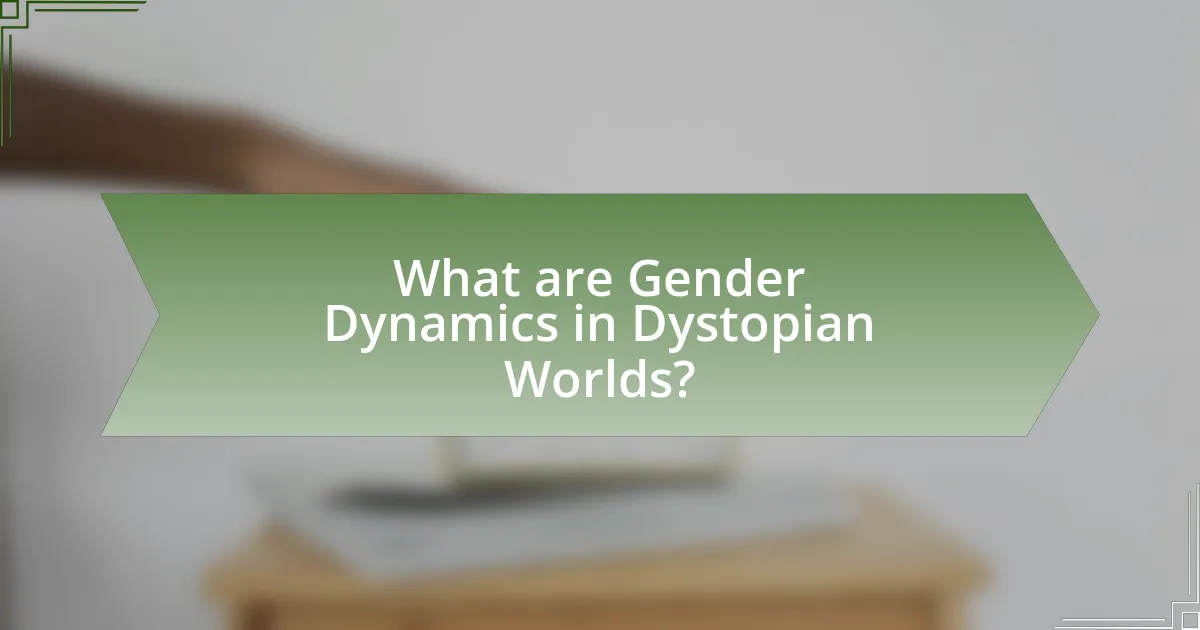
What are Gender Dynamics in Dystopian Worlds?
Gender dynamics in dystopian worlds often reflect extreme inequalities and power imbalances between genders, typically portraying women in subservient roles while men hold positions of authority. In many dystopian narratives, such as Margaret Atwood’s “The Handmaid’s Tale,” women are stripped of their rights and autonomy, serving primarily as reproductive vessels, which highlights the societal fears surrounding female agency and sexuality. This portrayal serves as a critique of patriarchal structures, illustrating how oppressive regimes manipulate gender roles to maintain control. Furthermore, studies indicate that these dynamics are not merely fictional; they resonate with real-world issues of gender inequality, as seen in various historical and contemporary contexts where authoritarianism exacerbates gender oppression.
How do dystopian narratives portray gender roles?
Dystopian narratives often portray gender roles by emphasizing extreme inequalities and societal expectations based on gender. In many dystopian settings, women are frequently depicted as subservient, relegated to domestic roles or stripped of autonomy, as seen in works like Margaret Atwood’s “The Handmaid’s Tale,” where women are reduced to their reproductive capabilities. Conversely, male characters often embody power and authority, reinforcing traditional patriarchal structures. This portrayal serves to critique contemporary gender dynamics by exaggerating existing disparities, illustrating how oppressive regimes manipulate gender roles to maintain control and suppress individuality. Such narratives highlight the consequences of rigid gender norms, prompting readers to reflect on the implications of gender inequality in their own societies.
What are the common stereotypes associated with gender in these narratives?
Common stereotypes associated with gender in dystopian narratives include the portrayal of women as passive victims and men as dominant protectors. These narratives often depict women in roles that emphasize their vulnerability, such as being dependent on male characters for survival or rescue. Conversely, male characters are frequently shown as strong, aggressive, and resourceful, reinforcing traditional notions of masculinity. For instance, in many dystopian stories, women are relegated to domestic roles or are objectified, while men are positioned as leaders or warriors, reflecting societal expectations and power dynamics. This pattern is evident in works like “The Handmaid’s Tale” by Margaret Atwood, where women are subjugated and men hold authority, highlighting the entrenched gender inequalities that persist in these fictional worlds.
How do these portrayals reflect societal norms and values?
Portrayals of gender dynamics in dystopian worlds reflect societal norms and values by illustrating the consequences of extreme gender roles and inequalities. These narratives often exaggerate existing societal issues, such as patriarchy and misogyny, to critique contemporary gender relations. For example, in Margaret Atwood’s “The Handmaid’s Tale,” the subjugation of women serves as a commentary on real-world issues like reproductive rights and gender oppression, highlighting how societal values can shift towards authoritarianism. Such portrayals reveal the dangers of complacency in the face of gender inequality, prompting audiences to reflect on their own societal norms and the potential for regression.
Why is it important to analyze gender dynamics in dystopian literature?
Analyzing gender dynamics in dystopian literature is crucial because it reveals how societal structures and power relations shape individual identities and experiences. Dystopian narratives often exaggerate real-world gender inequalities, allowing readers to critically examine the implications of these dynamics on both personal and societal levels. For instance, in Margaret Atwood’s “The Handmaid’s Tale,” the subjugation of women serves as a commentary on contemporary issues such as reproductive rights and gender-based violence, highlighting the potential consequences of extreme patriarchal control. This analysis not only fosters a deeper understanding of the text but also encourages reflection on current gender issues, making it relevant to ongoing social discourse.
What insights can we gain about contemporary gender issues?
Contemporary gender issues reveal significant disparities in power, representation, and rights across various societies. For instance, the World Economic Forum’s Global Gender Gap Report 2021 indicates that it will take an estimated 135.6 years to close the global gender gap in economic participation and opportunity. This highlights ongoing challenges such as wage inequality, underrepresentation in leadership roles, and limited access to education and healthcare for women and gender minorities. Furthermore, movements like #MeToo and Black Lives Matter have underscored the intersectionality of gender with race and class, emphasizing the need for inclusive approaches to address systemic inequalities. These insights illustrate the complexity of gender dynamics and the necessity for continued advocacy and policy reform to achieve equity.
How do these analyses contribute to feminist literary criticism?
Analyses of gender dynamics in dystopian worlds contribute to feminist literary criticism by revealing how societal structures perpetuate gender inequality and oppression. These analyses dissect narratives to uncover the ways in which female characters are marginalized or empowered, thereby highlighting the intersection of gender with power dynamics. For instance, examining works like Margaret Atwood’s “The Handmaid’s Tale” illustrates how dystopian settings can serve as a critique of patriarchal systems, showcasing the consequences of extreme gender roles. Such critical examinations provide insights into the representation of women and challenge traditional literary canon, reinforcing the importance of feminist perspectives in understanding literature’s role in reflecting and shaping societal norms.
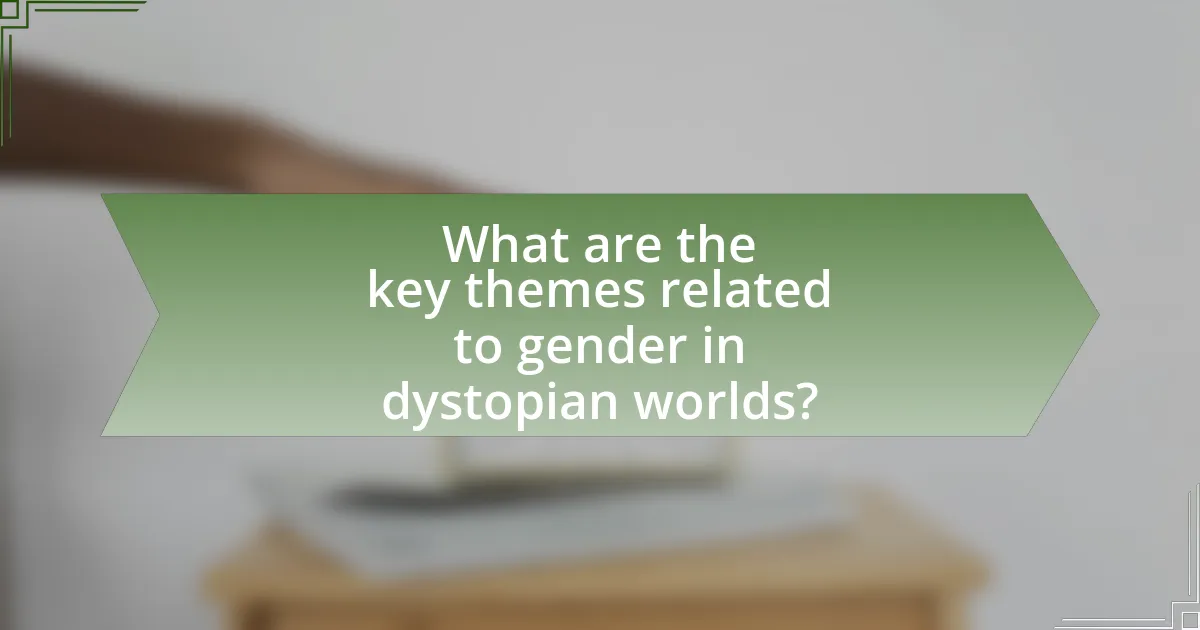
What are the key themes related to gender in dystopian worlds?
Key themes related to gender in dystopian worlds include oppression, power dynamics, and identity. Dystopian narratives often depict societies where gender roles are strictly enforced, leading to the subjugation of women and marginalized genders. For instance, in Margaret Atwood’s “The Handmaid’s Tale,” women are stripped of their rights and autonomy, illustrating the theme of systemic oppression. Additionally, power dynamics are frequently explored, showcasing how patriarchal structures maintain control over individuals. In George Orwell’s “1984,” the manipulation of gender roles serves to reinforce the state’s authority. Identity is another critical theme, as characters often struggle with their sense of self in oppressive environments, reflecting broader societal issues regarding gender and individuality. These themes highlight the complexities of gender relations and the impact of authoritarian regimes on personal freedoms.
How do power structures influence gender dynamics?
Power structures significantly influence gender dynamics by establishing hierarchies that dictate roles, behaviors, and opportunities based on gender. In many societies, patriarchal systems prioritize male authority, leading to systemic inequalities that affect women’s access to resources, decision-making, and social mobility. For example, research by the World Economic Forum in the Global Gender Gap Report 2021 indicates that countries with stronger patriarchal norms exhibit larger gender gaps in political representation and economic participation. This demonstrates how entrenched power structures can perpetuate gender disparities, limiting women’s agency and reinforcing traditional gender roles.
What role does patriarchy play in dystopian societies?
Patriarchy serves as a foundational structure in dystopian societies, often manifesting through systemic oppression and control over women and marginalized groups. In these settings, patriarchal norms dictate social hierarchies, limiting women’s rights and freedoms, which is evident in works like Margaret Atwood’s “The Handmaid’s Tale,” where women’s roles are strictly defined and regulated by a male-dominated regime. This control is reinforced through laws, cultural practices, and violence, illustrating how patriarchy not only shapes individual identities but also enforces societal stability through fear and subjugation. The prevalence of patriarchal systems in dystopian narratives highlights the critique of gender inequality and the consequences of unchecked power dynamics.
How do alternative power structures challenge traditional gender roles?
Alternative power structures challenge traditional gender roles by redistributing authority and agency, allowing individuals to transcend conventional expectations based on gender. In many dystopian narratives, such as “The Handmaid’s Tale” by Margaret Atwood, alternative power dynamics emerge where women gain leadership roles or form resistance groups, thereby subverting patriarchal norms. This shift not only empowers marginalized genders but also destabilizes the binary understanding of gender roles, as seen in various characters who defy societal expectations. The presence of these structures illustrates that gender roles are socially constructed and can be redefined through collective action and alternative governance models.
What impact do dystopian settings have on gender identities?
Dystopian settings significantly impact gender identities by often reinforcing traditional gender roles or subverting them to highlight societal inequalities. In many dystopian narratives, such as Margaret Atwood’s “The Handmaid’s Tale,” women are stripped of autonomy and reduced to reproductive roles, illustrating how oppressive regimes can manipulate gender identities to maintain control. Conversely, works like “The Hunger Games” showcase female protagonists who challenge patriarchal structures, thereby redefining gender roles and empowering new identities. These contrasting representations reveal how dystopian environments can serve as a critique of contemporary gender dynamics, reflecting and amplifying existing societal tensions regarding gender identity and power.
How do characters navigate their gender identities in oppressive environments?
Characters navigate their gender identities in oppressive environments by employing strategies of resistance, adaptation, and subversion. For instance, in Margaret Atwood’s “The Handmaid’s Tale,” the protagonist Offred navigates her identity by reclaiming personal agency through memories and small acts of defiance against a totalitarian regime that seeks to erase her individuality. This illustrates how oppressive systems force individuals to find subtle ways to assert their identities, often through internal dialogue or clandestine relationships. Additionally, research by Judith Butler emphasizes that gender identity is performative, suggesting that characters may adapt their expressions of gender to survive within oppressive structures, thereby highlighting the fluidity and resilience of identity in the face of systemic constraints.
What are the implications of gender fluidity in these narratives?
The implications of gender fluidity in narratives, particularly within dystopian contexts, include the challenge to traditional gender norms and the exploration of identity as a fluid construct. These narratives often depict characters who navigate and redefine their gender identities, reflecting societal shifts towards greater acceptance of non-binary and fluid identities. For instance, in works like “The Left Hand of Darkness” by Ursula K. Le Guin, the portrayal of a society where gender is not fixed encourages readers to question the rigidity of their own gender constructs. This exploration can lead to broader discussions about power dynamics, social roles, and the impact of oppressive systems on individual identity. Such narratives serve as a critique of binary gender systems, highlighting the potential for liberation and self-discovery in a world that recognizes and embraces fluidity.
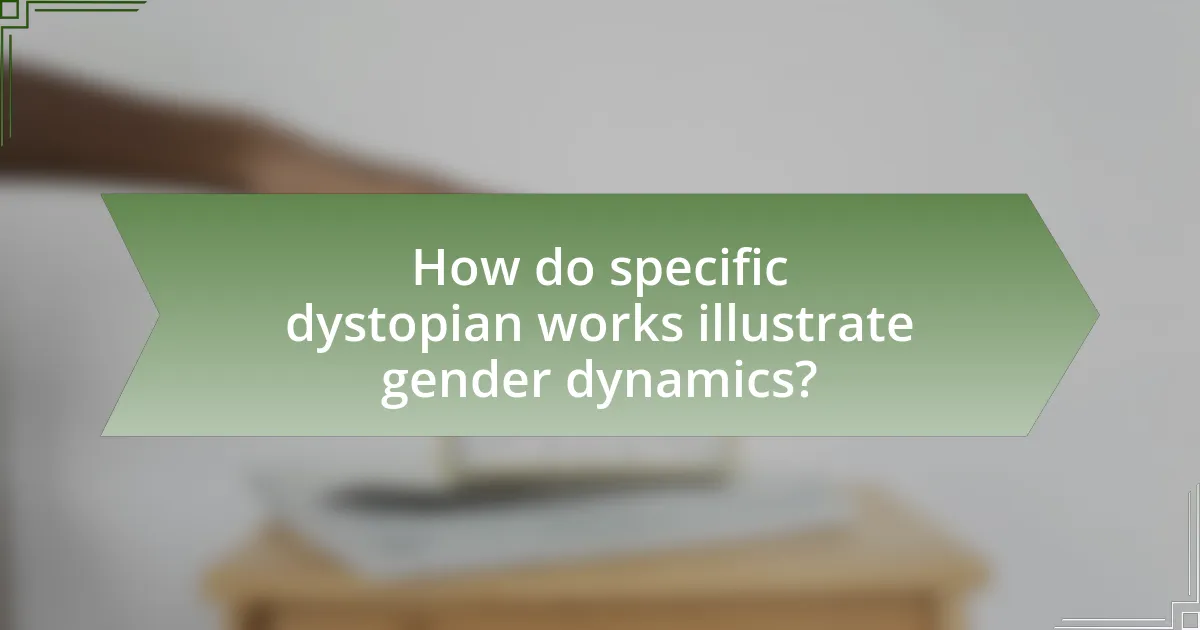
How do specific dystopian works illustrate gender dynamics?
Specific dystopian works illustrate gender dynamics by depicting societal structures that enforce gender roles and highlight the oppression of women. In Margaret Atwood’s “The Handmaid’s Tale,” for example, the totalitarian regime of Gilead reduces women to their reproductive capabilities, showcasing a patriarchal society that strips them of autonomy and rights. This reflects real-world historical contexts, such as the subjugation of women in various cultures and the ongoing debates about reproductive rights. Similarly, in George Orwell’s “1984,” gender dynamics are explored through the character of Julia, who navigates a repressive regime that seeks to control personal relationships and sexuality, emphasizing the state’s intrusion into private lives. These narratives serve as cautionary tales, illustrating how dystopian settings can amplify existing gender inequalities and provoke critical discussions about power, control, and resistance.
What examples can we analyze for gender representation?
Examples of gender representation in dystopian worlds include “The Handmaid’s Tale” by Margaret Atwood, which portrays a society where women are subjugated and used for reproduction, highlighting themes of control and resistance. Another example is “1984” by George Orwell, where gender roles are manipulated by the Party, illustrating the impact of totalitarianism on personal relationships and identity. Additionally, “The Power” by Naomi Alderman explores a world where women gain physical dominance, challenging traditional gender hierarchies and examining the consequences of power dynamics. These works provide critical insights into how gender representation shapes societal structures and individual experiences in dystopian settings.
How does “The Handmaid’s Tale” depict gender oppression?
“The Handmaid’s Tale” depicts gender oppression through the systematic subjugation of women in a totalitarian society where their roles are strictly defined and controlled. In this dystopian world, women are stripped of their rights, reduced to their reproductive capabilities, and categorized into rigid roles such as Handmaids, Wives, and Marthas, which illustrates the extreme patriarchal control over female bodies and identities. The narrative highlights the use of religious justification for this oppression, as the regime enforces biblical interpretations that prioritize male authority and female submission. The protagonist, Offred, experiences constant surveillance, loss of autonomy, and the threat of violence, which serves as a powerful commentary on the consequences of extreme gender inequality and the erasure of women’s agency.
What gender dynamics are present in “1984” and how do they manifest?
In “1984,” gender dynamics are characterized by the oppressive control of women and the reinforcement of traditional gender roles. The Party enforces a patriarchal structure where women are primarily viewed as instruments for reproduction and loyalty to the state, exemplified by the character of Julia, who navigates her sexuality within the confines of Party ideology. The Party’s slogan, “War is peace. Freedom is slavery. Ignorance is strength,” reflects the manipulation of personal relationships, reducing intimacy to mere acts of rebellion against the regime. Additionally, the character of Big Brother symbolizes male authority, while the absence of strong female figures in positions of power highlights the systemic marginalization of women. This dynamic manifests through the portrayal of women as subservient and the use of sexual repression as a means of control, ultimately illustrating the broader theme of dehumanization in the totalitarian society of Oceania.
What lessons can be learned from these analyses?
The analyses of gender dynamics in dystopian worlds reveal that societal structures significantly influence gender roles and power relations. These narratives often illustrate how oppressive regimes exploit gender to maintain control, as seen in works like Margaret Atwood’s “The Handmaid’s Tale,” where women’s reproductive capabilities are commodified. Furthermore, the analyses highlight the resilience and agency of female characters, demonstrating that even in oppressive environments, individuals can resist and challenge the status quo, as evidenced by the character of Offred who navigates her limited autonomy. These lessons underscore the importance of examining gender as a critical lens to understand broader societal issues and the potential for resistance within oppressive systems.
How can these insights inform our understanding of current gender issues?
Insights from dystopian narratives reveal how societal structures and power dynamics shape gender roles, thereby informing our understanding of current gender issues. For instance, the portrayal of women in oppressive regimes often highlights the consequences of patriarchal control, as seen in works like Margaret Atwood’s “The Handmaid’s Tale,” where women’s rights are stripped away, reflecting real-world concerns about reproductive rights and autonomy. Additionally, these narratives can illustrate the intersectionality of gender with race and class, emphasizing that gender issues are not isolated but interconnected with broader social injustices. This understanding can guide contemporary discussions on gender equality, as it underscores the importance of addressing systemic inequalities that persist in society today.
What strategies can be employed to challenge gender norms in society?
Strategies to challenge gender norms in society include education, advocacy, and representation. Education initiatives that promote gender equality can dismantle stereotypes by informing individuals about the harmful effects of rigid gender roles. Advocacy efforts, such as campaigns and policy changes, can create systemic shifts that support gender inclusivity. Representation in media and leadership positions can also challenge traditional norms by showcasing diverse gender identities and roles, thereby normalizing non-conforming behaviors. Research indicates that societies with higher gender equality in education and employment experience lower rates of gender-based violence and discrimination, reinforcing the effectiveness of these strategies.
